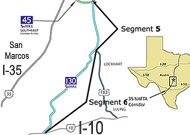Link to article here. The article mentions SB 792, the private toll moratorium bill that KILLED the 281/1604 private toll deal. But true to form, TxDOT is breaking the law and pursuing foreign control of 1604 toll lanes anyway. The article also notes that up to nearly $200 million in GAS TAXES may subsidize the toll lanes, making the tolling of these existing corridors a TRIPLE TAX (we’ve paid a tax for what’s already built, our tax money will be used to build the improvements, and then a lifetime TOLL TAX on top of that)!
Three to bid on U.S. 281 toll road project
10/24/2007
By Patrick Driscoll
Express-News
Three private groups are now in the hunt to build U.S. 281 toll lanes, but two big foreign companies competing just a short while ago to build and lease a larger toll network here have dropped out.The Alamo Regional Mobility Authority board voted Wednesday to let all three teams submit plans to rebuild U.S. 281 north of Loop 1604 into a tollway with free access roads by 2012. It’s the fledging agency’s first project.
“Goodness knows we have been two and a half years getting here,” board member Bob Thompson said. “Maybe it’s even more important to see the confidence of these three large companies. It adds some credibility, it adds some stature to what we’re trying to do.”
The three teams include 29 construction, engineering and public affairs companies.
Fluor Enterprises Inc. of Irving and Balfour Beatty Infrastructure Inc. of Atlanta lead the Cibolo Creek Infrastructure team. Both joined to develop the Texas 130 toll road east of Austin.
Zachry Construction Corp. of San Antonio and Texas Sterling Construction Co. of Houston lead the other teams.
Zachry joined with Cintra of Spain to produce a plan for Trans-Texas Corridor toll lanes and rail lines that would parallel Interstate 35, and in 2005 offered to build and lease a 47-mile toll network on U.S. 281 and Loop 1604 in San Antonio.
But Cintra isn’t part of the group angling to add U.S. 281 toll lanes now.
A tolling bill from last spring’s legislative session busted plans for the San Antonio network by banning privatization of U.S. 281 toll lanes.
Now Texas Department of Transportation officials say they’re working with Cintra and Zachry, as well as the other international bidder, Macquarie of Australia, to see if privatizing Loop 1604 toll lanes would make financial sense without U.S. 281 in the package.
Mobility Authority officials, saying they want to keep toll rates “reasonable,” want to develop Loop 1604 toll lanes without leasing them and losing some of the profits.
On the U.S. 281 tollway, motorists would pay 17 cents a mile at the start, with fees rising 2.75 percent a year until 2017 and then 3 percent annually after that, under a plan the authority board approved Wednesday.
The toll lanes would go from Loop 1604 to Marshall Road or Comal County, depending on whether regional planners allocate $69 million or $112 million in state funds to subsidize the project. Another $80 million subsidy could be needed for five interchange connectors at Loop 1604.
“There isn’t surplus revenue in the case of 281,” authority Director Terry Brechtel said.
The latest estimates for the U.S. 281 tollway — in 2006 dollars — are $426 million for construction and $220 million for upkeep over 40 years.
On Monday, Texans Uniting for Reform and Freedom filed a lawsuit to challenge the makeup and procedures of the Metropolitan Planning Organization, which oversees federal transportation dollars and is set to approve U.S. 281 toll rates in December.
The lawsuit, which claims that discussion and debate are being shut down, seeks to remove nonelected officials from the planning board.
Toll road advocates call the lawsuit frivolous.


 The Texas Department of Transportation (TxDOT) has agreed to consider lowering the maximum speed limit on a stretch of interstate highway that competes with a planned toll road. Cintra-Zachary, a joint Spanish-US venture, paid TxDOT $1.3 billion for the right to collect tolls on 40-miles of State Highway 130 set for construction beginning in 2009. Although TxDOT suggested that free market competition was part of the goal of using a public-private partnerships to construct and operate roads, the contract it signed on March 22 to construct this portion of SH130 was specifically designed to limit the desirability of alternate, free routes.
The Texas Department of Transportation (TxDOT) has agreed to consider lowering the maximum speed limit on a stretch of interstate highway that competes with a planned toll road. Cintra-Zachary, a joint Spanish-US venture, paid TxDOT $1.3 billion for the right to collect tolls on 40-miles of State Highway 130 set for construction beginning in 2009. Although TxDOT suggested that free market competition was part of the goal of using a public-private partnerships to construct and operate roads, the contract it signed on March 22 to construct this portion of SH130 was specifically designed to limit the desirability of alternate, free routes.